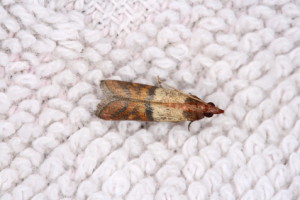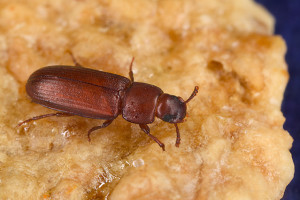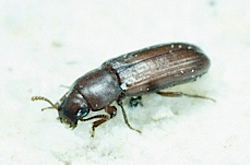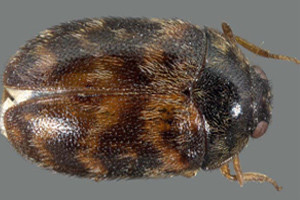
Indian Meal Moth
Appearance
Elongated body with brown-tipped wings
Color
Adults have gray bodies with brownish-bronze wing markings; larval stage is cream
Size
Adults are approximately 3/8 inch long
Habitat
Within dried food items as larvae; adults live briefly near food items that will make suitable habitat for larvae
Interesting Facts
Adult Indian meal moths do not feed, so they typically live less than a week
About the Indian Meal Moth
Adult Indian meal moths are distinguishable by their unique wing markings.
The female lays approximately 245 eggs, and it’s in this larval stage that meal moths feed in order to develop to adulthood. Many types of stored foods provide habitat for the larvae, including grains, pet food, dried herbs, flours and more.
The larvae produce small silks to bind themselves to the food items, consuming until they hatch. In less than a week, the Indian meal moth reproduces and lays another bath of eggs for the cycle to begin anew.
Indian Meal Moth Control
If you have flours, grains, pet food or other dry items that aren’t sealed tightly, check these first for signs of meal moth infestation. Sometimes, it can be hard to detect, especially if the color of the larvae is similar to the foodstuff they’re using as habitat.
All infested products should be immediately discarded.

Red Flour Beetle
Appearance
Elongated, flat and shiny body with two antennae protruding from its head; thorax displays curved sides
Color
Range of reddish-browns
Size
Approximately 1/8 inch long
Habitat
Within damp, damaged and/or improperly stored grain-type foodstuffs
Interesting Facts
Although nearly identical, the red flour beetle’s life cycle is shorter than the confused flour beetle
About the Red Flour Beetle
Red flour beetles and confused flour beetles are very similar is color, shape, size and even habitat. The red flour beetle, however, has more bulbous antennae and arched thorax sides.
These beetles feed mainly on starchy materials, such as broken corn kernels, grain and meal. For this reason, they can become a damaging nuisance pest in many agricultural sectors where grain storage is necessary. They can also get into your stored food items in your restaurant kitchen, causing contamination and waste.
Females lay approximately 450 – 500 eggs which are covered in a sticky secretion so fine grains and food particles stick to them. After developing and feeding from their habitat, they live for approximately one year.
Red Flour Beetle Control
It’s contamination of the food source that is of most concern with red flour beetles. Cast off skins and shells; feces; and other contaminants are left behind. This can cause feed to be rejected by livestock, as well.
Prevention is your best plan of action against these beetles. Keeping foodstuffs tightly sealed and moisture free is necessary.

Confused Flour Beetle
Appearance
Elongated, flat and shiny body with two antennae protruding from its head; thorax displays straight sides
Color
Range of reddish-browns
Size
Approximately 1/8 inch long
Habitat
Within damp, damaged and/or improperly stored grain-type foodstuffs
Interesting Facts
Females can lay 450 – 500 eggs per batch
About the Confused Flour Beetle
Confused flour beetles, like red flour beetles, live off damaged grain. They are unable to feed off of whole grain, so you’ll find them in the off cast, fine grounds, in filtration systems and in areas where the grains have become moist.
Because they are small – and they are fast when disturbed – they can quickly become deeply embedded in grain storage containers. Large egg yields lead to rapid contamination, and in agricultural sectors, this can lead to livestock refusal of feed. In the home, confused flour beetles can become a nuisance and damage dried, stored food items, including pet food.
Confused Flour Beetle Control
Properly seal and store all grains, including cereal, cornmeal, dried beans, seeds and herbs. These goods, if broken down at all, become potential habitats for confused flour beetles.
If you notice contaminated foodstuffs, discard immediately.

Warehouse Beetle
Appearance
Elongated, ovular and covered in fine hairs
Color
Two-colored; dark brown with three, light brown, wavy bands around its body
Size
Approximately 2 - 5 millimeters long
Habitat
Within grain processing plants, flour and other types of dried, stored foods
Interesting Facts
Adult warehouse beetles can fly
About the Warehouse Beetle
The warehouse beetle has a voracious appetite, and once the female finds a suitable food source item to lay her eggs in, she can deposit approximately 100. The process from egg to adulthood takes about 30 days, and although adults are drawn to light, larvae and pupae stage warehouse beetles disdain it and prefer to remain buried.
Warehouse beetles, like red flour beetles and confused flour beetles, are fast when disturbed. Any signs of pests in your food supply should be treated with care, discarding contaminated and potentially contaminated items immediately.
Warehouse Beetle Control
Don’t mix new and old grains and flour together if there are any signs of contamination; properly clean areas regularly; seal tightly all food storage containers.



